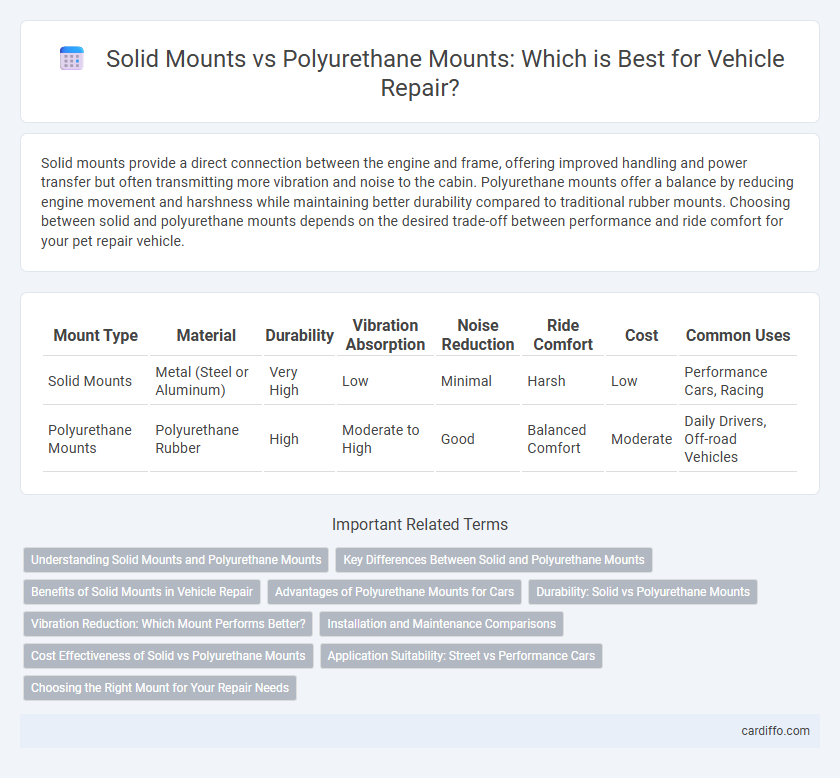Solid mounts provide a direct connection between the engine and frame, offering improved handling and power transfer but often transmitting more vibration and noise to the cabin. Polyurethane mounts offer a balance by reducing engine movement and harshness while maintaining better durability compared to traditional rubber mounts. Choosing between solid and polyurethane mounts depends on the desired trade-off between performance and ride comfort for your pet repair vehicle.
Table of Comparison
| Mount Type | Material | Durability | Vibration Absorption | Noise Reduction | Ride Comfort | Cost | Common Uses |
|---|---|---|---|---|---|---|---|
| Solid Mounts | Metal (Steel or Aluminum) | Very High | Low | Minimal | Harsh | Low | Performance Cars, Racing |
| Polyurethane Mounts | Polyurethane Rubber | High | Moderate to High | Good | Balanced Comfort | Moderate | Daily Drivers, Off-road Vehicles |
Understanding Solid Mounts and Polyurethane Mounts
Solid mounts provide maximum stability and durability by using rigid materials that minimize movement and vibration transmission, ideal for high-performance applications. Polyurethane mounts offer enhanced flexibility and improved vibration isolation compared to solid mounts, balancing durability with comfort and noise reduction. Understanding the material properties and performance characteristics of solid and polyurethane mounts helps optimize repair decisions for vehicle suspension and engine support systems.
Key Differences Between Solid and Polyurethane Mounts
Solid mounts offer maximum rigidity and direct power transfer, improving engine response and handling precision, but they transmit more vibration and noise to the chassis. Polyurethane mounts provide a balance by absorbing vibrations and reducing noise while maintaining better durability and flexibility compared to rubber mounts, though they allow slightly more engine movement than solid mounts. Choosing between solid and polyurethane mounts depends on the desired trade-off between comfort, noise insulation, and performance in repair or upgrade scenarios.
Benefits of Solid Mounts in Vehicle Repair
Solid mounts provide superior durability and strength in vehicle repair, ensuring minimal movement and enhanced stability compared to polyurethane mounts. Their rigid construction reduces vibrations and improves handling precision, leading to better vehicle performance and longevity. Solid mounts also require less frequent replacement, lowering maintenance costs and downtime for repairs.
Advantages of Polyurethane Mounts for Cars
Polyurethane mounts offer superior durability and resistance to oil, chemicals, and abrasion compared to solid mounts, resulting in a longer lifespan for car components. They provide enhanced vibration isolation and noise reduction, improving overall driving comfort and reducing wear on the vehicle's suspension system. These mounts maintain better performance under extreme temperatures and stress, making them ideal for high-performance and off-road applications.
Durability: Solid vs Polyurethane Mounts
Solid mounts offer superior durability due to their robust metal construction, making them highly resistant to wear and tear in heavy-duty repair applications. Polyurethane mounts provide a balance between durability and flexibility, resisting oil, chemicals, and abrasion while minimizing noise and vibration. For long-term repair projects requiring maximum lifespan and structural integrity, solid mounts are often preferred over polyurethane options.
Vibration Reduction: Which Mount Performs Better?
Solid mounts provide a rigid connection that minimizes movement but often transmit more engine vibrations directly to the chassis, resulting in a rougher ride. Polyurethane mounts offer a balance by absorbing and dampening vibrations while maintaining stiffness, which significantly reduces noise and improves overall comfort. For optimal vibration reduction, polyurethane mounts generally outperform solid mounts due to their enhanced elasticity and damping properties.
Installation and Maintenance Comparisons
Solid mounts require precise installation to ensure proper alignment and secure fit, often demanding more effort and time during setup compared to polyurethane mounts. Polyurethane mounts offer easier installation due to their flexibility and durability, reducing the need for frequent adjustments. Maintenance of solid mounts typically involves less frequent replacement but can be more challenging, while polyurethane mounts generally require more regular inspection and possible replacement due to wear and tear.
Cost Effectiveness of Solid vs Polyurethane Mounts
Solid mounts offer greater cost effectiveness due to their lower initial price and durability under heavy-duty conditions, reducing frequent replacements and labor costs. Polyurethane mounts, while pricier upfront, provide enhanced vibration isolation and longer service life, potentially lowering overall repair expenses over time. Evaluating total cost of ownership, including maintenance frequency and performance benefits, will guide the best economic choice between solid and polyurethane mounts.
Application Suitability: Street vs Performance Cars
Solid mounts provide superior engine and transmission stability by minimizing movement, making them ideal for high-performance cars where precision and response are critical. Polyurethane mounts offer a balanced solution with more vibration dampening than solid mounts, suitable for street cars that require comfort alongside improved handling. Choosing between these mounts depends on the vehicle's primary use; performance cars benefit from the rigidity of solid mounts, while street cars gain from the durability and reduced noise of polyurethane mounts.
Choosing the Right Mount for Your Repair Needs
Solid mounts offer superior rigidity and direct engine connection, ideal for high-performance repairs requiring minimal engine movement and enhanced throttle response. Polyurethane mounts provide a balanced combination of durability and vibration dampening, making them suitable for everyday repairs where comfort and noise reduction are priorities. Selecting the right mount depends on the specific repair requirements, vehicle usage, and desired performance characteristics.
Solid mounts vs Polyurethane mounts Infographic

 cardiffo.com
cardiffo.com